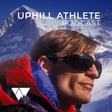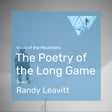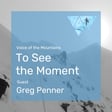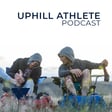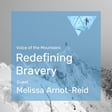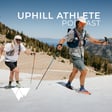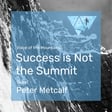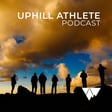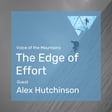Become a Creator today!Start creating today - Share your story with the world!
Start for free
00:00:00
00:00:01

The Aging Athlete
Join Uphill Athlete founders, Steve House and Scott Johnston, for a discussion of the aging process in athletes. In this episode, they outline their top six rules for athletic longevity, as well as answer questions from the Uphill Athlete community about training and performance as we age.
Transcript
Introduction to Uphill Athlete and Resources
00:00:01
Speaker
Welcome to the Uphill Athlete Podcast. These programs are just one of several free services we provide to disseminate information about training for mountain sports. If you like what you hear and want more, please check out our website, uphillathlete.com, where you'll find many articles and our extensive video library on all aspects of training for and accomplishing a variety of mountain goals. You'll also find our forum, where you can ask questions of our experts and the community at large.
00:00:30
Speaker
Our email is coach at uphillathlete.com and we'd love to hear from you.
Challenges of Aging Athletes
00:00:36
Speaker
Welcome everyone. This is our Uphill Athlete Zoomcast podcast recording about questions for the aging athlete. My name is Steve House. I'm the co-founder of Uphill Athlete and with me today is none other than Scott Johnston. Hey Scott, how are you doing today?
00:00:56
Speaker
Hey, Steve, yeah, I'm the resident senior citizen in this crowd. So I think I have some authority to speak about this subject. I think it's something that we get hit up a lot with questions. Obviously, there's a lot of folks in our age range. You're what, just turn 50, right?
00:01:17
Speaker
I actually turned 50 in two weeks. Don't make me any older than I am. Two more weeks than my four days. I get your birthday and Sam Naney's birthday mixed up. Okay, sorry. He just turned whatever. He's still a young pup though. But anyway, yeah, we got people in that 50 and up range. We got quite a few of those folks that pay attention to what we have to say and we get questions about how they can adjust what they do to still be active, not get hurt.
00:01:44
Speaker
And so we've decided that it was kind of a good idea, I think, to have a conversation about some of these things, and especially since you're about to become a card-carrying member of the Old Farts Club. I mean, I'm actually, I even have a Social Security thing now, so I'm definitely in there.
00:02:05
Speaker
And I think that one of the things that I want to point out is that we, both of us, and me doing a longer time than you have been doing this a long time. Training, climbing, running, skiing, whatever it's been, I've been doing this kind of thing since I was a child, probably 12, 13 years old, with pretty much no breaks in there.
Rules for Fitness and Injury Avoidance
00:02:31
Speaker
at a pretty high level. And you likewise, sometime in your teenage years, started this up. And so we've got a lot of experience of what it was like to be an athlete when we were younger and now trying to remain as active and athletic as we can. And I think we have some stuff to share. And I think that one of the things that I
00:02:56
Speaker
I've put together are some kind of some little rules that I think would help people give some guidance and they're pretty simple. Um, and we can elaborate on those rules as we go through the talk today, but why don't we start with some of those? Yeah, well, let's start with rule number one, which I think is one of the best ones. And that is a simple one. It's just don't stop.
00:03:21
Speaker
Yeah. What do you, what, how do you, how do you think of that? I mean, obviously you're talking about not stopping being active, not stop training on stop doing the sports that you love. Um, tell me about that.
00:03:36
Speaker
Yeah, well, I think that it sort of speaks for itself. And it's very simple, of course, but the reason I put it as rule number one is I believe it's the most important. Because when you stop, it's just going to take you a lot more time to get back to a level of fitness. By stopping, I mean, and we'll get into injuries and that sort of thing later. But whether you stop because of work or family or injury or illness or whatever it is,
00:04:03
Speaker
that layoff, maybe it's two weeks, maybe it's six months, maybe it's a year, whatever it's gonna be, it's gonna be a whole lot harder to come back from that at our advanced age than it was to bounce back from that, any kind of a layoff when you were 30 years old. And I chalk this up to this concept that I've never, I don't think I've ever heard of this from anybody else, but I call it youthful vigor.
00:04:31
Speaker
I think when we're young, we have all this extra energy and we adapt quickly to training. You can stay up all night partying and then go out and run 20 miles the next day or go and do some big climb and pretty much handle this massive amount of work when you're young. And I kind of chalk it up to that youthful vigor that just comes with youth.
00:04:53
Speaker
And by maintaining an active lifestyle and training the way you and I have done and a lot of the folks that we know have done, I think you can
00:05:03
Speaker
delay or reduce the drop off in that youthful vigor, but it's still gonna drop off. And you're not gonna be able to come off the couch and perform at the level you once were able to. So by not stopping, I think that gets back to some one of our rules of, we have these three rules, as you know, in our Training for the New Alpinism book that training must be first is consistent.
Risk and Injury Management
00:05:30
Speaker
and it's got to be progressive and it needs to have modulation you know some hard some easy and this gets into the consistency thing and if you're not consistent it just you know it's going to be very hard to make much progress and so do what you can to
00:05:46
Speaker
prevent any significant layoffs and one of those things will be don't get injured don't get sick which actually leads us right into rule number two. Well I just want to say too that this gets harder as you in middle age and an a bit more advanced age too.
00:06:03
Speaker
life gets more complicated, more things come up, work gets more involved, families get more complicated, family life and having families of your own. So there's a big reason that I think that we see a lot of middle and advanced age athletes is coming to us because they have fallen off the wagon, so to speak. They are trying to
00:06:25
Speaker
get back on and making a big conscious effort but it's but it's a big challenge i think we need to acknowledge that that's the reality for for most people and you know take heart just do it and that gets back to one of our other rules that we'll get to in a second but rule number three which these are all of course related but new rule number rule number two is do not get injured do not get hurt
00:06:49
Speaker
That seems pretty simple, pretty self-explanatory. And it ties into rule not stopping, right? Because it's harder to come back from these injuries. And the older we get, the more of these injuries we have, it seems like. So, which ties into some of our other rules. We'll get to it in a second, but yeah.
00:07:06
Speaker
Don't get hurt. How do you do that? Well, you know, I think that one of the things that helps me and I believe and I think you would agree that your risk tolerance is much lower now than it was 30 years ago.
00:07:20
Speaker
and mine is definitely lower and so and part of that is because we've both been hurt really badly in the past and you know near death experiences and you realize oh I am a mortal after all and it was one thing to do that when you're 25 and it's another to do it when you're you know 50 or so there's a reason we send 20 year old men into battle and not 60 year old men into battle
00:07:45
Speaker
I've never thought of that because we'd all be cowards. And I think that you have to take that into consideration. So for me, that helps set a little bit. It's not a self-imposed.
00:08:00
Speaker
limitation but it's a limit it's more of a subconscious limitation so and I'm sure you can you feel similar to this long runouts on shaky gear or bad rock or you know something you're going to avoid like the plague now as compared to something you might have even sought out 20 years ago or 30 years ago
00:08:20
Speaker
And similarly, you know, overuse injuries from a lot of these sports that we talk about, you know, running and being one of the biggest culprits in injury, the injury world, being careful to, and we're going to talk about maintenance work that needs to be done.
00:08:38
Speaker
but being careful to not develop overuse injuries. So when you start to feel that little niggling pain in your Achilles tendon, you stop and walk home and then you deal with it and get over it. You don't just hop out, continue your run or go do another run the next day, even though your Achilles tendon is sore.
00:08:59
Speaker
because that's going to be one of these things that could potentially derail your training and make you have to stop. So I think the risk tolerance part, and maybe it's risk for injury too, not danger injury like climbing protect particularly, but the injury that would be related to something like overuse, or you probably don't ski as steep a line as you once liked to ski for some of that same reason.
00:09:24
Speaker
Well, like for me, one of the things that was interesting as I got older and had been through a few injuries and recoveries, as you pointed out, sometimes I'm climbing
Strength and Training Balance
00:09:34
Speaker
and I look down at a run out and I feel like I can almost feel the injury in my body that would happen if I blew it right there. And I consequently carry a lot more fear than I used to when I'm in those situations. And I think that's,
00:09:52
Speaker
frankly just experience like I do know what it feels like to take those bad balls and do have those have those bodily injuries. And I've endured a few of them. So I think that that it makes you a little gun shy, so to speak, you know, you've you felt the felt the kick before and you're like a little you're kind of almost anticipating it, which is
00:10:14
Speaker
Which is not the nicest thing, but that's part of getting older and as they say wiser. Yeah, a little bit wiser, hopefully. I think our rule number three really supports one and two in a lot of ways and the simplest, shortest version of it is to do more strength training. Spend more time in the weight gym. But I would also include, you know,
00:10:39
Speaker
power, agility, balance work, mobility work. I would lump all those things kind of together there.
00:10:51
Speaker
How would you explain doing more strength to people? What is the value of that? I think a lot of older people are actually a little shy of strength training because they're worried about getting hurt. Yeah, exactly. Well, I think the package you just described, and we can lump all these things together, strength, power, agility, balance, mobility, those are not
00:11:12
Speaker
the standard things that we as more endurance-oriented athletes typically want to do. We just want to go out and go for a run in the mountains or go ski touring or go out and do some kind of a climb. We often don't really want to focus on these activities and when we were younger, we had a lot of that youthful vigor gave us a lot of strength, power, agility, mobility, you know, all that stuff just kind of came because we were young.
00:11:38
Speaker
And we now, I think, have to realize that it's going to take some supplemental training to maintain more youthful levels of those qualities that allowed us to move more gracefully or whatever. I mean, I notice it with my rock climbing now. I'm often, you know, I'm really stiff. It's harder for me to make some harder, more difficult, I should say, for me to make some hard moves because I just don't have the same kind of flexibility that I once had.
00:12:08
Speaker
And so I think that what I recommend for people, when I do myself, I'll just tell you what I do myself, is I probably spend, I'm sure, in terms of strength training, I'm sure I spend at least three hours a week working on strength. And it doesn't necessarily have to involve lifting heavy weights. It can be body weight, strength exercises. We've got tons of good information on that in our,
00:12:37
Speaker
on our website and but i think it it's like just going out and going for a run is not going to be very good strength training that's you know the great aerobic training but chances are that you're not operating anywhere near your uh strength limit so you're not going to improve strength when you're doing these kind of low intensity high volume activities power i feel like fits into this package
00:13:05
Speaker
Similarly, to strength, power is the next stage beyond strength. That's what athletes really want to be, is powerful. We don't really need to be all that strong to do what we do, but we do need to have good power so you can run uphill quickly or
00:13:22
Speaker
Do jump turns on your skiing down a steep pool bar. Be able to lunge for that, you know, handhold that's just out of reach. All those kind of things involve power. And power is a quality that is kind of placed on top of strength. In other words, it's the strength supports the power. So what I recommend for people, the older folks is that they work on developing strength first.
00:13:49
Speaker
And when their strength is adequate for the task that they're trying to achieve, then they begin to add in power. And the power that's coming in then will be
00:14:01
Speaker
would be in the form of more sport specific activities like if you're a runner or skier maybe it's going to be hill sprinting or hill bounding and if you're a climber it's going to be doing you know campus board or some kind of work like that. The other thing that goes away with age is definitely balance and I think balance training is something that most people can
00:14:24
Speaker
can do you don't need to go out and invest in a slack line and then you know fall off it and break your wrists or anything like that but you know just something as simple as having a two by four in your yard you have to walk back and forth on or and get used to turning around on it and squatting down and standing up on it and just little really simple drills i believe can go a long way and there's a ton of information about balance training on the internet too
00:14:51
Speaker
But in kind of keeping after those sorts of things I believe is going to be what gives Aging athletes a better opportunity to maintain the lifestyle that they enjoy Rather than let's say, you know going out and doing another set of hard uphill running intervals now those probably will help your fitness for sure but in the long term, I think that
00:15:18
Speaker
doing these auxiliary activities that I've just talked about that aren't necessarily very specific to the sport you're training for will have the biggest effect on your long-term durability.
00:15:29
Speaker
When we talk about aging athletes getting weaker, and as you pointed out, a lot of older athletes don't really want to do any strength training because they're afraid they'll get injured. But that's a sort of a self-fulfilling prophecy. If you don't do much strength training, the chances are you are going to get injured. You're going to slip on the ice. You need to catch yourself. Anyway, I just feel like that's a big issue for a lot of folks.
00:15:53
Speaker
Yeah, and I know we've often advised older athletes to absolutely do the strength training, but also advise them or warn them that it's a more gradual approach. You're not going to adapt as quickly as you did when you were running and, you know, burying your head in the sand isn't the solution, but actually doing it, accepting that it's probably going to be a longer timeframe than maybe it used to be, or maybe you've never done strength training
Maintenance and Recovery Strategies
00:16:17
Speaker
and just
00:16:17
Speaker
Start making it part of your sort of weekly practice of health and fitness and training. That's going to go a long way. So we'll get into more of that when we get to some of our specific questions, I'm sure.
00:16:31
Speaker
And the next one is related again, these are, as I said, all related, but rule number four is do more maintenance and recovery work. And maintenance and recovery work often happen in the gym, and what do you tell people about maintenance?
00:16:48
Speaker
Well, for me, and I'll tell you why I think this is really important, that as we age, our connective tissue, and by connective tissue, I mean primarily the tendons that hold the muscle, attach the muscles to the bone, and the fascia, which really the fascia is what holds us together. It allows us to, you know, it keeps our body shaped the way it is. But all those tissues are quite elastic when we're young.
00:17:15
Speaker
but they lose their elasticity. And it's the reason that I can't jump. I used to have a 32 inch vertical leap. I'm sure now it might be 22 or 20 inches if I'm lucky, maybe even 15 inches. And we're not as springy and elastic as we were once. And that makes it, as I pointed out earlier, that also makes us, we're less flexible when we're trying to get bigger ranges of motion out of our joints.
00:17:42
Speaker
But it also impacts, I think when you're training at a fairly high level, if you're training seriously and you're kind of training close to your body's ability to whatever it can handle, and this is of course going to vary from person to person, and it's not really important what that level is,
00:17:59
Speaker
you're going to feel yourself getting tighter and tighter and tighter. Your muscles are not going to want to loosen up between training bouts. And so I find for me, a little routine that I try to do every day for like 15, 20 minutes is stretching and then foam rolling my legs, especially because running seems to really hammer my legs these days more than it used to. So I spent a lot of time foam rolling my legs, foam rolling, you know, other tight spots like in my back or whatever.
00:18:28
Speaker
And I consider that part of this recovery work. And the reason I like to call it maintenance work is that we're like an old car. It's going to take a lot more maintenance to keep this car on the road than it did when we were younger. We didn't have to change the oil very often 30 years ago, but now that thing
00:18:48
Speaker
going to break down if we don't take care of it. And so I like to think of it as maintenance work. Another way to look at it is pretend you're a Formula One car. And for every hour those Formula One cars are on the track, you probably get about 10 hours of maintenance on them. The older you get, the more you're like that. You need a lot of maintenance time.
00:19:10
Speaker
So I'm, I'm a big believer in that. I think that has made the biggest difference for me to be able to continue to do the kind of things I like to do is, you know, the days that I don't, you know, I fall off the wagon, don't do that. I really notice it. It really impacts my ability to recover and be able to go do stuff the next day. I can remember like through those 10 years when you were coaching me, basically more or less through my late twenties to late thirties,
00:19:40
Speaker
I didn't even own a foam roller. Now I've never have a, I've never wore that about six feet from a foam roller. There's like seven of them in my house. I always have one. They're all a little different. Um, I mean, yeah, I concur with all of that. I spend a lot of time with that too. And I think that that, that is just something we have to make part of our, part of our routines. And especially if you've been carrying around a bunch of injuries, you know, and a lot of people getting to be our age,
00:20:08
Speaker
have accumulated a lifetime of injury from various things. And those injured tissues, especially because they've got formed scar tissue and that scar tissue is not like healthy tissue. So it's not as elastic, doesn't respond the same way. And so that I think is another reason why older people need to spend a little more time doing this maintenance. The problem for most of us is that's going to cut into the time we'd like to be training. But
00:20:36
Speaker
my argument against that would be if you don't do the maintenance training, then you're probably also going to be cutting into your time you have for training because you're going to get injured. Pay now or pay later. Yeah, exactly.
00:20:49
Speaker
Yeah, as you know, I mean, I have these old injury 10 year old injury now where I had two ribs that are smashed into about 20 to 30 pieces. And I have to go and have those worked on every two to four weeks, depending on what I'm doing. And when I now it's 10 years out, it used to be I had to go every week.
00:21:08
Speaker
So, I mean, I really can't live without that work, that body work that I have done every couple of weeks or every month at the least frequent. And I think a lot of us are at our ages are carrying injuries of various kinds and we need to invest in that kind of work. It just has to be part of our routine, part of our life. That's a great way to think of it. It's an investment in your future ability to maintain this lifestyle.
00:21:38
Speaker
You know, I've got a replacement knee, as you know, and we had a little interruption. Yeah, excuse me. That's okay. Are you needed? Yeah, apparently my four-year-old could not read the sign on the door that said recording. I should have locked it. Oh, well.
00:22:00
Speaker
No big interruption.
Adjusting Expectations with Age
00:22:02
Speaker
But like you, you've got all those broken ribs and really smashed up parts of your body. And I've had seven surgeries on one knee finally culminating in a knee replacement. And I still run on it quite a bit. But I find if I don't do this maintenance, I really do notice it. And people are going to notice this to a greater or lesser extent. And everybody needs to find the right level of maintenance and recovery work.
00:22:30
Speaker
But I know that you have, and I have too, you've kind of experimented and tried different things. And, um, and you got, you know, whether it's finding the right massage therapist or finding the right roller or finding the right place to roll, whatever, um, it's going to, there's no one recipe that's going to fit everybody here. Rule number five is an interesting one that strays a little bit from our, our trend so far. And it is check your ego at the door.
00:22:58
Speaker
Yeah and I think that this is an interesting one because it gets into the mental aspects of aging as an athlete and to me what it refers to is you know not expecting ourselves to perform physically the way we used to be able to and not
00:23:18
Speaker
beating ourselves up when we can't or when we don't and also I think that relates to just the training not just the sort of performances whether it's a race or a route you've been working on or something but just the day-to-day what you can do and what you can recover from is really different and when I think back on some of the weeks of training I did in my 30s
00:23:42
Speaker
I mean, they would absolutely cripple me now. I wouldn't even be able to complete a week like that.
00:23:50
Speaker
And that's just the reality. And it is quite a journey, as I know you and I have talked about many times over the last 15 years, that is quite a journey to come to some peace with that. And I know that we've heard from a lot of people who also struggle with that mental journey. So that's something I think we'll get into a couple of other times.
00:24:12
Speaker
I think it's one of the interesting ones. What's your experience with checking your ego at the door? It's not easy. It's definitely not. If you've been kind of a lifetime athlete and especially if you were, no matter what you were doing as an athlete, if you were doing it at 25, you're not going to be able to probably come close to that at 50.
00:24:40
Speaker
I think that the realization that we have to come to, that I'm not going to be 25 yet again in my life, it's a stark, it's a real reality, and we don't have any, there's no magic bullet pill at this point that helps us get around this. So the sooner we can come to grips with that, and because it requires a recalibration,
00:25:05
Speaker
of your expectations and knowledge like I'm sure you and I certainly do a lot of the guys that I hang out with and do stuff with are half my age and I can't go out and climb with them every day or I can't go ski touring with them every day or even when I go ski touring with them I'm I used to be the one that was always out in front breaking trail now I'm the one
00:25:27
Speaker
begging them to break trail for me and i'm still you know bringing up the rear and and then i'm then the next day i'm really tired because i've been going pretty hard trying to keep up with those guys and i've had to sort of
00:25:42
Speaker
tone it down and go, okay, maybe I need to do more ski touring by myself because I'm just, it's too hard for me to go out with these young fit guys. So I think it's coming to grips with that fact will mean, you know, maybe it's finding new partners. Maybe it's doing more by yourself or having, because you can't expect your 30 something year old partners that are half your age to always be waiting for you. That's not fair for them either.
00:26:11
Speaker
And it's going to create, you know, they may feel, you're going to feel like you're holding them back. It's, you don't want to have, you don't want to be a sympathy case. So I don't know, wish there was a great simple answer to that.
00:26:24
Speaker
Yeah, we'll get into that some more later. Rule number six is our last rule. And I think it's, um, one of the most simple, most clear, most straightforward. It simply states start yesterday. So, and that goes back to rule number one a little bit and kind of closes the circle with don't stop. It's like you want to keep going. You want to start your fitness training journey. We get it restarted, continue it, whatever ASAP start yesterday.
00:26:54
Speaker
Delaying is only going to make it harder. As hard as it might feel to get started, it's only going to get harder as you go along. So yeah, I think that's a really, really, really important one for people to realize and to try to act upon.
00:27:13
Speaker
Let's dive into these questions. These are questions that we solicited via the newsletter. If you haven't subscribed to our newsletter on the uphill athlete website, there's usually a little pop-up that comes up the first time you visit. Please do so.
Listener Questions: Aging and Training Adjustments
00:27:29
Speaker
We'll send out once a week on Wednesdays. We send out some information, free training knowledge.
00:27:35
Speaker
The first question, these first questions referred to what we would categorize as work capacity type training. And the first question is, what adjustments do I need to apply to my volume and intensity over time to cater for the impacts of aging? So.
00:27:56
Speaker
Well, yeah, that's a great question. It is, but I think it's a really good place to start and it because it's going to inform a lot of it fits in with some of these rules. It's going to inform a lot of what we talked about from here on out. And that is that
00:28:13
Speaker
It takes longer to recover from some kind of work now than it did when we were younger, unless you weren't very fit when you were young. And we're going to get to that here in a few minutes. But let's assume this person's been a fairly active person for most of their life. And from that question, it sort of sounds like they have been. But the fact that you don't recover as quickly
00:28:40
Speaker
means that the density of work that you can do, whether it's in an hour or a week or a month or a year, you can't do as much work as you once were able to do, both high and low intensity, because you got to have more time in between those bouts of work that we would call workouts maybe. You need to have more time between those so that you can recover from it and go back out there and do it.
00:29:04
Speaker
My own pet theory is that that's one of the reasons as we get older that we aren't as fit. I mean, my mitochondria probably still respond to training just like they did 30 years ago. But it takes me longer to recover from that training session than it did 30 years ago. So I can't do the same volume. I can't do the same intensity that I did. And as a consequence, anybody who does less work
00:29:33
Speaker
or less training, let's call it, less training, is gonna be less fit than they would if they did more training. So it's like, we're just saying, okay, I can't train 800 hours a year anymore. Maybe I can train 400 hours a year at my age. Well, and there's no way I'm gonna be as fit as I was when I was training 800 hours a year. So I think that's something that we have to take in, that helps sets the, maybe sets the stage for answering this question is,
00:29:58
Speaker
that the appropriate volume and intensity, obviously it's going to have to reduce. So you first that's, but there's no, I can't tell you, Oh, you need to reduce that 10% per decade or something. It's very, it's way too individual for that. It depends on your, your genetics. It depends on your training history, depends on what you're doing and injuries, all those kinds of things. But it's going to be up to you to find the appropriate training volume and training intensity.
00:30:25
Speaker
that allows you to recover and get stronger. And one of the simplest rules I have for finding that is if you're not fitter like two weeks from today and you're training fairly consistently and regularly, there's a chance that the problem is you're not recovering enough.
00:30:44
Speaker
you should be able to see some kinds of fitness gains, whether it's on the aerobic end of things, your ability to hike or run uphill, or your strength gains in gym, a number of pull-ups you can do. If you can't see much of it, the needle doesn't move in two weeks, unless you've been lying on the couch and cheating and not doing anything. But if the needle doesn't move in two weeks, you're probably overdoing it. And so I would say for this person, that would be the way I would gauge it is, am I getting fitter or am I just getting more tired?
00:31:15
Speaker
When we had our second son, I had a layoff. And when I got back to doing some strength training, the first workout I could only do six pull-ups.
00:31:29
Speaker
When I was at my peak, I could do around 80 to 100 pull-ups in a single sitting without even dropping off the bar. And so that was a little bit of a wake-up call, but like three workouts later, I could do 10.
00:31:46
Speaker
And that was like I did two strength workouts a week. I did two strength workouts, felt like dog food for those first two, and then came back three, four days later and I went from six to 10. So that's what you're kind of, that's maybe a bigger response than a lot of people would have.
00:32:06
Speaker
I'm not trying to humblebrag here, but just to scale that for people. But like what you said, the needle moved, and I can see it, and we're in a very direct, measurable way.
00:32:18
Speaker
And I think the, you know, intensity also kind of to me often includes strength training or gym based strength training. And probably as a percentage of things that's going to move up, right? Like you're going to just have to spend more time doing all these things we talked about when we went over the rules. Um, and, um, that's going to increase the, that's going to shift the distribution towards intensity slash strength, uh, in terms of your total, how you spend your total available training time.
00:32:46
Speaker
Yeah, absolutely. And something else I think it's important to keep in mind, especially if you've been a lifelong athlete.
00:32:55
Speaker
as you age is that it, first of all, you can't handle as big a training load as you once did, but I don't think those massive training loads are necessary for an athlete that's had, you know, an extensive training history in the past.
Training Adaptations for Lifelong and New Athletes
00:33:10
Speaker
In fact, I think they can be kind of detrimental because they're going to, they're going to get into the, they're going to make you feel like, oh, I need to train like I did when I was 35.
00:33:18
Speaker
and they're probably going to make you too tired. You're not going to get better. So I think that less can be more for endurance athletes. You know, there was certainly, you know, long periods of time in my life where I was probably averaging 80 miles a week of running. Well, obviously I can't do that anymore, but I also find that
00:33:39
Speaker
I don't, I don't get better. Once I get over about 25 miles, 25 to 30 miles a week, I'm not, I don't, I can tell my fitness isn't getting any better. That's about the limit of what I can handle and still see gains. And I think it's sort of what you're talking about. So with the strength is the same way, you know, if you went into the gym and said, okay, I'm going to do, you know, eight sets of 10 pull ups right now, that would be a really, that'd probably set you back.
00:34:07
Speaker
But if you take a more gradual approach and creep into that, you'll find the limit at which you stop making gains. And I think that's an important thing. But I've just noticed with aging, older people don't need the same high volume that they did when they were younger. And I think it's even working with some of the lifelong professional athletes that I work with that are in their late 30s, early 40s,
00:34:35
Speaker
They don't do as well with as much volume as they did when they were 25. Yeah. Well, aging is a separate subject. We're not going to go into the details of the weeds of that, per se. But here's a really good question with a fairly easy answer, I think. How does aging impact my rate of improvement in the training cycles?
00:35:00
Speaker
I mean I think straight up we got to say the rate of improvement is going to be longer, slower, however you want to phrase that. When you apply the training stress over time and then reduce that training load to get your peak, your
00:35:21
Speaker
It's just going to take more. Each peak is going to be smaller and it's going to just overall take a lot more time to get somewhere with your fitness. It's just the fact of life at this point. And in a way, I think this is one of the things I think we can say with some assuredness is that if you've been a lifelong athlete,
00:35:45
Speaker
your rate of improvement is gonna be even less. All you're gonna be able to do is slow the rate of decline because you've already had your peak fitness years, they're behind you now. Whereas if you're 50 years old and you're just getting started in a fitness program, then you're probably gonna see some pretty significant gains over the next 15, 20 years. Their gains can be made because you weren't very fit when you started.
00:36:09
Speaker
But certainly for someone like you or myself, Steve, the best we can do, and it's a little demoralizing to feel like, okay, I'm paddling the canoe as hard as I can upstream and I'm still drifting back downstream right now. I think that's another tough thing to have to accept that the best we can do is slow the rate of decline.
00:36:35
Speaker
So here's another question from Casper.
00:36:41
Speaker
This goes into what you just alluded to is making gains in your aerobic base as you get further along in life. What I would like to know is how to start as an aging athlete. Athletes who have a life of fitness behind them in a very good base have to adapt to aging. But how is this for some, for 50 something athletes who have no or not much base due to a sedentary lifestyle and or lack of time and who once over 50 find themselves with more time to develop their fitness and want to improve
00:37:11
Speaker
Set themselves some bucket list goals, etc. How to start and what to pay attention to.
00:37:17
Speaker
That's exactly what you're just alluding to. And I think it's a great question, and I really commend Casper for stepping up and asking it, because a lot of people would just want to hide behind the tree and pretend that none of this existed. But he's actually stepping up, getting the information he needs, and going to make some changes. And what it sounds like has been a pretty sedentary life and do some stuff.
00:37:42
Speaker
So that's pretty cool. So just want to start with that. And what would you say? How to start? What to pay attention to? Those are great questions. Well, you certainly can use some of our rules apply right here. Rule number six is start today.
00:37:58
Speaker
and don't get hurt. And so in order to not get hurt, Casper, somebody who's getting started at 50 years old or something like this, they're going to have to have an even more gradual approach because they don't have that youthful vigor. They don't have the elasticity in their connective tissue that they once had.
00:38:16
Speaker
So they're going to be more prone to overuse injuries. They're going to have really stiff mornings. And so I think that a very gradual approach, and it might be something as simple as a two mile walk every day for a while, it will be some body weight exercises, strengthening type exercises. But I think that the
00:38:38
Speaker
you wouldn't, the worst thing a person like someone like this could do would be to look at what somebody who's been a lifelong athlete is doing and then try to jump into that program with them because that's almost for sure gonna end up in a bad way, injury, overtraining, something like that. So nobody can tell you how many pushups you should be doing or how long you should be hiking or running
00:39:07
Speaker
Those are something you're going to have to figure out for yourself, but the only way to figure out is going to be do kind of run an experiment with on yourself is, okay, this week I'm going to go, you know, I'm going to try a mile a day and see how I feel, but being consistent with that so that it's a mile every day.
00:39:27
Speaker
being consistent with I'm going to know, as we mentioned earlier, we've got these at home no no equipment strength training programs on the website for free so people can come on there and and get get some of those and try some of those exercises I've had a few older folks.
00:39:44
Speaker
Oh, I tried to do the killer core routine and oh my God, I couldn't do any of those exercises. Well, obviously the killer core routine is too hard for you then, which is why we've created the basic core routine. That would be a better place for somebody like that to start and then do that for a few months and then shift over to
00:40:00
Speaker
the killer core routine, which is much harder. So finding the appropriate level, I think is the best advice I could give to somebody like that. And the appropriate level, like I said, you know, unless you had somebody on the ground right there watching you, the appropriate level is going to be found by you experimenting and finding out what does and doesn't work and paying attention to fatigue, paying attention to injury, that sort of thing.
00:40:25
Speaker
Yeah, there's a lot to pay attention to and it can be overwhelming. So it can be worthwhile searching out a coach, whether it's somebody working remotely or somebody working in person with you. I would caution people. I don't want to make rules for people, but caution people about group type classes. I think
00:40:45
Speaker
you know, as you get older, you're more and more of a unique specimen and you need more and more exactly what's right for you and not too much. Again, we talk about the rules of continuity, gradualness and modulation over and over and over again, and everything we write and talk about with uphill through uphill athletes and gradualness and modulation are going to be
00:41:08
Speaker
absolutely key to pay attention to. But it's a lot. And if you need more guidance, don't be afraid to ask, as Casper clearly isn't. The next question is, how does age impact... This is sort of a similar question to one we had. How does age impact the ratio of aerobic threshold work to high intensity work? I believe they're not talking at all about strength training. Let's just restrain ourselves for the time being to the aerobic
00:41:37
Speaker
side of the equation. How would you answer that? There's another one where it's going to be hard to come up with a hard and fast rule for this person. Yeah, for sure. Well, like I mentioned a few minutes ago, my mitochondria are going to respond to training the same way they did as when I was 25 years old.
00:42:00
Speaker
So I need the same kind of aerobic-based training that I needed when I was 25 years old, when I'm 65 years old. But I think what we have to think about or what I've started to think about more about is how to add some intensity training in there because as we get older and we get a little bit weaker,
00:42:22
Speaker
It's harder for me, for instance, to go out and run fast. So I don't get that high intensity training stimulus that I once did. It used to be really easy for me. Oh, I just pick up the pace here for a few minutes, even if it was random. And there is some strength component to high intensity aerobic work, because it takes more power to propel somebody at six minute miles, and it does a 10 minute mile.
00:42:45
Speaker
And so there is a little bit of a crossover there. And so what I like to suggest is that, especially for the aging athlete,
00:42:57
Speaker
that you do plan, unless you're massively aerobically deficient, you should probably plan one higher intensity work session per week. But my preference for that for most of the aging population that we deal with would be to use something like our gym, ME,
00:43:16
Speaker
training program, because that's going to have a strength and an aerobic training component to it. It's not so repetitive. You don't have to be able to run six minute miles. A lot of people can't run at all at our age. How are you going to get it? Your high intensity.
00:43:33
Speaker
You know, maybe especially if you don't live in a, you live in a flat place, you can't hike a six minute mile. So you're not going to have that option. Maybe you don't have access to a stair machine or a steep treadmill. So it could be hard to elevate your heart rate. But the beauty of that muscular endurance training program, which we've got on the website, it's pretty easy to find this type in muscular endurance at home training program.
Managing Aerobic and Anaerobic Balance
00:43:58
Speaker
The beauty of that is it's going to combine
00:44:01
Speaker
an aerobic session and a muscular endurance strength type session into one workout. And it's not so repetitive that it's likely to leave you injured like going out and doing, you know, 400 meter repeats on the track might end up, you know, somebody blowing a hamstring or
00:44:21
Speaker
a you know pulling an achilles tendon or getting plantar fasciitis. Running lower leg running injuries are or leg leg running leg injuries in running are so common and we're going to talk a little bit more about injuries later but so I that's where my recommendation would be how to sprinkle in high intensity for the aging athlete. Just to use some musculon endurance questions. Okay well what
00:44:46
Speaker
Another question from Miles, what rate of increase in training is appropriate for those over 50? I assume he's talking about kind of designing his macrocycle over a year period, or even from year to year.
00:45:04
Speaker
That's gonna depend on if he's like Casper and he's just getting started, chances are he's gonna be able to make big gains in a fairly short period of time. So his rate of increase of training load, and by load we could kind of combination of intensity and volume,
00:45:25
Speaker
But his increase in training load will be greater than somebody who's been at it for years and years and years, who may not make any increase in training volume. They just change the way they do their intensity work. So an older athlete with a long history of training,
00:45:43
Speaker
is probably going to be at a fairly static training volume. That's not going to be changing very dramatically. Whereas somebody, like I said, like Casper, or maybe Miles here, I'm not sure.
00:45:57
Speaker
If you're just getting started, something like 20% a year is probably gonna be a reasonable number. Whereas if you've been at this for your whole life, like you, like I was just saying about me anyway, I can't train 800 hours a year anymore. So for me, it's a matter of trying to find a level that still keeps me fit. And again, with Miles, I think you could be thinking about
00:46:21
Speaker
What's making you fitter is just going out there and making yourself tired isn't guaranteed to make you fitter if there's not an adequate recovery in there. So find what works for you in terms of both the volume and the rate of increase. And if you keep a good training log, and we're big advocates of using training peaks, I feel like it's an amazing tool for any athlete. If you keep a good training log like that,
00:46:50
Speaker
you're going to, within a few months, you're going to start to see patterns emerging if you study it carefully, if you take careful notes and you write into your writing training peaks. Oh, went out today and tried to run and my legs felt really hammered from those, you know, that session I did two days ago where I put in 4000 vertical feet and
00:47:08
Speaker
Now not recovered so then you'll go. Oh, I need I needed more time. I needed more recovery time between those workouts and that's one of the reasons we've always advocated having Some sort I'm very minimum should be a spiral notebook that you write down stuff in And you know, it can get much more sophisticated than that with heart rate GPS monitor all that Larry asked
00:47:36
Speaker
Does age, say over 60 years old, affect your definition or measure of aerobic deficiency syndrome? Does it affect recommendations concerning the zone 3 and 4 workouts? No, it doesn't affect the definition of aerobic deficiency syndrome. In other words, you want to still find
00:47:57
Speaker
To determine if you've got aerobic deficiency syndrome, first you're going to want to identify your aerobic threshold, and then you're going to need to identify your anaerobic threshold, the upper, more high intensity threshold. And then if those are more than 10% apart in terms of heart rate or pace, then you're aerobically deficient and you need to spend more time working on your aerobic base to elevate that aerobic threshold closer to the anaerobic threshold.
00:48:27
Speaker
it doesn't change. Your heart rate is going to be lower now over 60 than it was years ago, so you probably have to check it every year or every few months to see. You won't be able to elevate your heart rate as high as you were stable to in your youth. And so as you age, your aerobic threshold is going to go down in terms of heart rate.
00:48:50
Speaker
unavoidably just because your your maximum heart rate drops with age and I've asked a cardiologist friend about that why is that why why does that happen he he said nobody seems to know something to do with the drive and our sympathetic nervous system it just slows it all down
00:49:06
Speaker
but it doesn't really affect any of those formulas or how you would do, I mean, the mix of zone three and four workouts, zone three and four workouts still want to be a relatively small proportion of your training volume. Something under 10% or 15% range is probably adequate for almost everyone. So I wouldn't make any big shifts to any of that stuff. Yeah, that's great. I think you'll find that really helpful.
00:49:37
Speaker
Ian asked, I am now 63 years old, still hiking but not mountaineering or climbing at the level I used to. This is due to an illness which stopped me from doing anything much for nearly 10 years, but now only stops me from doing high intensity training. I am now training properly again, but really not sure if I should expect any fitness improvements at 63 years of age.
00:50:01
Speaker
Even if I am now training better than I have been for many years, is it just a case of managing the decline now? I would say not in his case. With a 10-year layoff, I think Ian's going to see some gains there.
Heart Rate and Recovery Monitoring
00:50:17
Speaker
And I would, you know, the reason you probably in, you know, I don't know what your medical condition was and why you're not able to do high intensity, but it, it may be the reason you can do high intensity training is you've lost enough strength over those intervening 10 years that you can't even, you can't elevate your heart rate to that.
00:50:37
Speaker
Level you can't put out that much effort because you're not strong enough to do it So I would say your strength your training should incorporate strength all those things we talked about before Strength and agility and mobility and that balance that sort of thing as well as the aerobic stuff that you're doing here
00:50:54
Speaker
And I think you might find that within a year or two, you will be seeing gains and you'll feel stronger and you'll be able to start adding in some high intensity after that. It just would really surprise me if that wasn't the case. Yeah, I would agree with that. I would think that he would have some gains to see here. Let's see, this came from Thierry.
00:51:22
Speaker
Hi Scott, this has been on my mind for a while. I am 70 years old and have been pretty active for the 50 years. I got into endurance sports over 30 years ago, running cross country skiing and biking. My question is on heart rate and what may be too much for the body to handle. My last event was a trail race at the age of 69 and my average heart rate was 161 for a five kilometer trail race.
00:51:49
Speaker
I also did the Chamonix vertical kilometer the next day that year too, heart rate the same. Recovery heart rate went down pretty quick. My average week is a 15 to 25 mile a week of running. I'm planning to do the UTMB as a tour over seven days in June, 2021 and hoping to
00:52:16
Speaker
Upping is mileage to 35 to possibly 70 miles per week. I do feel pretty good after workouts, not too stressed.
00:52:27
Speaker
I stand a lot for my job. Could I count the four miles a day I sometimes walk for my job as part of the training? Long question. So with the heart rate, I mean, here we have a guy who's able to go out and run a 5K trail race at 69 with 161 heart rate. That's a pretty high heart rate for a guy that age. And that indicates probably a pretty healthy ticker.
00:52:55
Speaker
Yeah, for sure. And also I think we could, I would suggest using that as his anaerobic threshold heart rate, especially if he did a vertical K the next day. So a 10 kilometer vertical K, I'm sure took him an hour, maybe more.
00:53:10
Speaker
And so that would be a great measure. That is what we would think about the anaerobic threshold is it is your endurance limit. It is the maximum output you can make for however long it is, usually something in the 30 to 60 minute range. So the fact that you went out and did this field test, which is the way we
00:53:31
Speaker
tend to tell people to find their anaerobic threshold is do this very same kind of field test, go as hard as you can or as long as you can. In this case, usually at least the 30 minutes, but preferably up to 60, and then set that as your top of zone three, and you're good to go. And the fact that your heart rate recovered quickly, and by quickly, what I would normally say would be like 30 beats per minute
00:54:01
Speaker
dropped within the first minute. That would be that would be what I would consider like when I have trained high level endurance athletes when we're doing high intensity work, we want to monitor the how much their heart rate drops during the recovery period, let's say during an interval session.
00:54:18
Speaker
So they finished their interval session and their heart rate. They finished a particular hard session in the interval workout, and maybe their heart's 180. Well, in a minute, we'd like to see it at least down 30 beats. And when it stops recovering that fast, that would be an indication that the athletes probably
00:54:38
Speaker
done with that workout is not recovering anymore. Let's say the first, you're doing some four or five minute hill repeats and the first two or three, you're fine. At the end of each one, your heart rate drops 30 beats in the first minute, but then like the fourth and the fifth one, your heart rate, it's only dropped like
00:54:58
Speaker
15 beats or 20 beats, then you'd go, oh, and you'd feel that in your legs. You know, you'd know that you were working a lot harder and chances are that would be that you're overexerting because your heart's not able to recover. So I would use things like that to monitor how your training is going. Now, one thing I would caution about would be
00:55:23
Speaker
It's going to have to be a very gradual increase from the 15 to 25 mile range up to the 35, especially getting up to the 70 mile range per week. I'd be a little
00:55:37
Speaker
cautious about that because of what we were just talking about a few minutes ago, Steve, where I don't know that aging athletes need or should be doing that much volume. There's potential, you know, if he's the history of doing 15 to 20 miles a week, 25 miles a week, that's talking about tripling that distance and going up to 70 miles per week. And my hunch is to Ray, you'd be better off in the, you know,
00:56:06
Speaker
peaking in the 30 to 50 mile range and probably only doing one or two weeks in that 50 mile range in preparation for that race, or that's not a race, it's a tour. So I would just, I'm not sure you need to, that would be the kind of thing I might tell a 30 year old who was doing a lot of running that they should be training in that 70 mile range. Yeah, and I would add to that, to keep in mind, and this applies to anyone regardless of their age, it's always better to be,
00:56:35
Speaker
one or two or 5% under-trained than it is to be one or two or 5% over-trained or injured or just out of the game. So, you know, if you're a professional athlete and you're, you know, racing a event like the Tour de Fons, it's going to be, you know, decided by less than a minute over 21 days of racing. Yeah. Okay. You need to be like right at the absolute limit of what you could handle in terms of your training every day for years.
00:57:04
Speaker
But most of us are not dealing with events or looking for outcomes like that. It's more important for us to just stay healthy from year after year and the older we get, as we talked about in the beginning, the more important
Psychological Adaptations to Aging
00:57:16
Speaker
that is. So it's best to always err on the side of caution.
00:57:20
Speaker
This again is where a coach and some individual attention can really help. It's hard to do that yourself. And to answer the last question he asked is if he could include his four days of walking and he does four miles of walking.
00:57:39
Speaker
or sorry four miles of walking. I mean you have to consider all the stress in your life that goes into your training but I wouldn't add that or track that probably other than to kind of keep tabs on it to see if it's
00:57:55
Speaker
Dramatically increasing or decreasing and that's just sort of the base that exists as part of your everyday existence Then that is what it is and maybe make sure it doesn't Suddenly go through the roof or something because then you'd have to accommodate for that additional fatigue But I wouldn't count that into my running miles because it's you're not running But it's interesting that standing
00:58:18
Speaker
I think standing can be more fatiguing than running, honestly. People that have to stand for their job. And I know this from my youth, I was working as a machinist and standing at a lathe or a milling machine for hours all day and then trying to go out and run after all my legs would just be so heavy and dead feeling. I think I know enough now that I probably would go home and foam roll him first and then go for my run. But I think
00:58:45
Speaker
You've got a stressful job that is going to make you tired, but not make you fit. And this is something that Steve and I have run into when we're trying to advise mountain guides on their training. So they have a job that involves
00:59:03
Speaker
Moving at a pace that for them is very slow and very easy to go, but it's still really tiring They're out for you know, eight ten twelve hours a day often with a heavy pack moving at a snail's pace Which is the pace their clients are going at? It doesn't do anything for their fitness really, but it sure as heck makes them tired, you know, they're there because they do this all the time They've already developed
00:59:27
Speaker
an adequate base of training. And they're not getting much training stimulus from that eight hours of being on their feet every day. It just makes them tired. And so I think to Ray, that's something you have to keep in mind is this is a fatigue producing thing that is not making you fitter. If you like going out and playing around a golf, walking on the golf course, playing around a golf, it would make you tired, but it wouldn't make you fitter.
00:59:58
Speaker
OK, so now we get into one of the questions which I was eager to dive into and share some anecdotes about.
01:00:07
Speaker
I don't have a name here, but it's asked, I have been skiing all modalities, trail running and biking for 35 plus years. And as I pass age 50, the biggest change is my speed. I can still run 13.1 miles and go to the office afterwards, but I have to start 20 minutes earlier so as not to be late for work. How do you give yourself grace and not beat yourself up over the increasing time to complete things that you used to be able to easily do?
01:00:37
Speaker
So this comes about, what was it? Rule number five, check your ego. Yeah, very much. Yeah. No, I think we've said most of what we can say about this, but it's, you know, that first of all, maybe you don't need to be running 13 miles every day before you go to work. Uh, that might, you might actually be fitter and faster if you ran less. Um, especially since it sounds like you've been doing this, you know, 35 plus years, you obviously have a great training base. Um,
01:01:05
Speaker
I would consider, you know, cutting back on my mileage and, you know, maybe adding a day of, and especially for somebody with this kind of a base, I would certainly think about adding, you know, something like kill sprints or some higher intensity running into my program.
01:01:20
Speaker
So I would, that would be my first thing, but I obviously this has to be the overarching issue here is how do you gracefully accept the fact that you can't do what you once did. And I mean, other than our own personal struggles with this, I mean, we have not, I know that I haven't and I doubt if you have stumbled on the
01:01:40
Speaker
you know, the kind of the holy grail of how to deal with that. It's just, it's an individual struggle for each person. But, um, well, I think that one of the things that we should, uh, shine the light on here is that it is a struggle and not pretend that it is not a struggle. Like I've struggled with this. You've struggled with this. This person is clearly struggling. And, and, and the clue is even in her or his, uh, his note, how do you give yourself grace? Well,
01:02:08
Speaker
you give yourself grace. You find it in yourself to say, ah, yeah, I can't run those 13 miles as fast as I used to, but that's just the way it is. At least I'm still here to run 13 miles. As a climber, it's also hard for me. I used to just be able to come off the couch and
01:02:32
Speaker
climb, you know, low to mid 512 without really trying and just be able to do that. And now I really have to work myself up to be able to climb at that level. And, you know, at least I get to come out and go climbing. And it's hard. I like to tell people, and I think this is
01:02:58
Speaker
something I deal with is if I go to a crag sometimes, not always, but sometimes, especially if it's people I don't know, if they know that I am a well-known climber,
01:03:12
Speaker
they may think it's funny that I'm actually so bad. And so for me, it's a big relief when I fall that first time. I can remember being at the crag in Slovenia years ago, probably about 10 years ago, one of my best cragging days of my life, actually, with this old friend of mine, Marco Lukic. And I've known Marco since I was 18.
01:03:38
Speaker
And he had climbed 9A. I don't even know what that is, like 515B or something. Really, really, really good sport climber. One of the best in the world. He was like, I think the fourth or fifth man to ever climb 9A. Maybe it's 14C, maybe it's 14D. I'm horrible at those. Anyway, excuse me, sport climbers, for not knowing those things.
01:04:01
Speaker
And I was at the end of the day at the crag, this young Italian guy who was real, you know, chomping at the bed and watching, and definitely knew who Marco was and was watching his every move, came up to him like, Marco's best climber that day had been 8A, which is about 13B, 513B. And the guy said to him,
01:04:28
Speaker
What's it like going from climbing day to day? That was an example of this sort of
01:04:45
Speaker
gracefully giving himself permission to go from you know what most people would consider climate 13b to be a great success and you know but he had climbed whatever 14c or 14d or whatever it was so he was able to kind of put it in context make a joke out of it be light-hearted with it and and give himself that permission and the funny thing is that this kid didn't really get it
01:05:08
Speaker
He was so into his quest for numbers that he couldn't quite, he just kind of gave it, he just kind of turned his head, gave this kind of confused look and sort of wandered away. We were just sort of laughing about it. We thought that was the best answer ever. So I think it's important. Many of you remember this time that you and I were ice climbing in Canada around
01:05:33
Speaker
2001 or 2002, and we went to this mixed climbing crag off of the Banff Jasper Highway someplace. I can't remember what it was called. And we were climbing there on, you know, relatively short climbs, and there's other people there. And somebody said something like, oh, you look, you look just like Steve House. And he said, well, I am Steve House. And the guy said, no, you can't be. He's a much better climber than you are.
01:06:01
Speaker
And it sort of broke the tension. It's like, okay, great. And then you said something like, oh yeah, yeah, I'm really not Steve House.
01:06:08
Speaker
Yeah. Yeah. No, those moments are great because then you can just like be yourself and whatever. Like everybody, like I think that with professional level athletes of any kind, people expect them to be like at their peak every time. And they go out and they climb if, you know, like the Chris Sharma goes out and climbs five 15 B every day of every week. It's like, no, he did that like once when everything was exactly perfect and the stars aligned and that's it. And like most of the time he goes out and he's probably pretty happy to climb a 13 B and that's just the reality.
01:06:38
Speaker
And so I think that we all need to give ourselves permission to not expect to set a PR every day. It's just not the way it works and everybody needs to understand that.
Recovery and Training Flexibility
01:06:54
Speaker
Here's another one, let's move on from that. How do you determine recovery times as you get older? It seems far more variable as I age. Any thoughts on why? And I think we both probably have thoughts on that. Go ahead, you can give me your thoughts first. Well, I would say that it ties into this last question that
01:07:19
Speaker
we don't when we're younger we bounce back quicker as we age especially i think this starts to happen in the 40s where sometimes you do bounce back and sometimes you don't and it's hard to know when and it has like you just the system is getting the car is getting older and it's easier to for it to lose its tune just it requires more maintenance it requires more upkeep it requires more of a perfect set of circumstances to be running and it's
01:07:46
Speaker
in its best condition. And so, you know, there's this kind of tongue-in-cheek saying that goes around the fitness world. There's no such thing as overtraining, only under-recovering.
01:08:00
Speaker
Well, obviously there is such a thing as overtraining, but as you get older, you can certainly find yourself under recovering and that's far more noticeable. And so there's a number of things that, you know, in our rules that this person is age could be doing to help shorten their recovery time between workouts by being more proactive in their, in their maintenance, their, their,
01:08:23
Speaker
stretching mobility and we'll talk about these and other future future discussions about injuries and about nutrition and so forth but there's a lot of other things that can be done that might affect that. One of the things I've noticed as of age is that there's there seems to be
01:08:45
Speaker
a less, not as good a connection between cause and effect. So some days I just get up and I'm tired. I didn't recover as well. I don't even know what I, it wasn't like I did something extraordinarily difficult the day before, but I just don't feel as happy as I feel like I should. And I wish I knew why that was. I'm an engineer by training. I want to know why these things are happening.
01:09:11
Speaker
I don't know. Steve and I have a friend who's older than both of us who calls these things the daily insult. And you don't really know what the daily insult is until you get up in the morning and go, oh, where's that pain coming from? Or why is that thing sore or tired? You just don't even know sometimes. And I think that's, again, part of the aging deal. But I think the takeaway from that, the message that I've tried to incorporate, although it's a challenge, I admit,
01:09:39
Speaker
Into my training is respect what your body is telling you just because you don't feel like you should be as tired as you perhaps are you haven't recovered as well. You should be by this age.
01:09:54
Speaker
pretty good at reading your body signals to you. I mean, our body sends us these kind of messages. And usually we, when we're younger, we tend to ignore them until the wheels actually come off. You can't, because we're gonna try not to get injured or have these big layoffs as we age, you have to be more attuned to these really subtle signals that your body is telling you. And one of the ways that I respond to that is, I might just say,
01:10:23
Speaker
Oh, I'm not ready to do what I thought I might be ready, what I was hoping to do. And being a somewhat compulsive personality, I mean, I usually, I mean, I had a perfect example. Yesterday I had hoped to get up and do some intensity, running intensity. I would hope to do some intervals running. And I got up and my legs just felt like lead. And I wasn't sure why. I didn't really know why. And instead I went sport climbing with a friend and, um,
01:10:48
Speaker
That was a perfect easier day for me. That way I didn't, my legs, you know, today my legs felt much better. I was able to go do that interval.
01:10:56
Speaker
workout that I wanted to do yesterday. So I think having the flexibility and respecting the fact that you're not a machine and you're not going to respond the same way every day. Um, you know, so you just have to, you have to do, you have to be like a coaches. I mean, Steve and I coach a lot of athletes. And of course we have a lot of coaches that work with many athletes. And one of the main functions of a coach is to
01:11:22
Speaker
tell the athlete, no, you're not ready to do that workout today. We're going to change today and do such and such much easier. We're going to do, even if it's just a totally a recovery session, all I want you to do today is some foam rolling and yoga or that sort of thing. Um, making those on the ground day to day decisions is what's going to separate, make your training work or not work. The last thing you want to be doing is getting completely wedded to
01:11:51
Speaker
a training plan without any variability and without the option of adjusting and training and changing things, which I will say that that's the reason we spend so much ink on the website and in our books talking about how to monitor your training and how to adjust it.
01:12:08
Speaker
That is the hardest part. Well, I have this little saying that any idiot can write a training plan. The problem is the proper administration of that plan. That's where the art of coaching comes in. And since most people are going to be self-coached, they need to develop that skill or they're going to run themselves into the ground. I think that's really common. People, especially if they're using a training plan, whether it's a purchased one or one they wrote themselves,
01:12:37
Speaker
They're type A people typically, and they want to do what's on paper, do what's on the calendar, and then follow through. And I'd say that's one of the most important roles I see is my, so in my coaching is checking in before people do the workouts to check in, you know, obviously, if it's a recovery day, I don't need to check in to see if they need to do a recovery workout. But if it's a big workout, I'm there checking in to see if they are
01:13:01
Speaker
Ready to do that day's big workout and i think it changes over time as we're younger like i think the hard days of training or when you.
01:13:10
Speaker
when you're sort of dreading a workout and you don't want to do it because you know it's going to be hard or painful or uncomfortable or you just don't want to go into the gym or whatever it is and you push through anyway. And that, those are the days that I think make a big difference. You learn mental toughness, you get the work done and you maintain your continuity and so forth. When you get older, it's the same mental strength as required, but it's changed a little bit where
01:13:39
Speaker
Exactly as you said in your example, you want to do what you laid out but you don't think you should and you have to have the discipline and the knowledge to modify it to be appropriate for you know where you're at that day and that is that is just as hard and that that in and of itself you know you got to remember we're keeping rule number what was it rule number two don't get hurt
01:14:04
Speaker
longevity as we get older longevity becomes a more and more of a focus in terms of our athletic longevity of our athletic careers and our activities. And keeping that in mind and being able to kind of suck it up and swallow the pride, checking our ego at the door, rule number six, four or five. And that's how we're going to see progress forward at these older ages.
01:14:31
Speaker
You know, one of the little rule of thumb that I like to tell the athletes I've worked with is because almost everybody who's involved in these kinds of activities is a type A personality, where by type A, what I mean is more is going to be better, harder is going to be better. You know, these people don't need to have a kick in the butt to get out the door training and said they need a hand on the shoulder to say, hey, wait a minute, maybe not today.
01:14:57
Speaker
But what I like to tell people when you're self coaching is if you have even an inkling of a doubt as to whether you should go do that workout, that's your body shouting at you. No, no, don't do this to me. Um, and I, I've just, I've learned that my own myself and that's the way I adjust it now like yesterday.
01:15:17
Speaker
I mean, yesterday, because I've been at this a long time, I could recognize the signs and I went, oh, this workout would not go well if I tried to do it today. I just would drive myself into a big hole if I tried to do that. But I think most people don't have that experience. And so I use that notion that, you know, normally the people we work with, the people who are interested in the kind of things we are, they are chomping at the bit to get out the door. And if they suddenly are not chomping at the bit,
01:15:44
Speaker
then that's a red flag and they should heed that. In my opinion, you should heed that red flag and change it up. Maybe do the warmup and see how you feel at the end of your warmup. And sometimes you can actually feel better at the end of a warmup. But if you're still feeling like, not that psyched at the end of the warmup, then pull the plug, go home, turn around, go home.
01:16:04
Speaker
and you come back stronger the next day. And I, as you know, Steve, I've worked with quite a few Olympians and there have been a number of workouts, many with some of the folks I've trained with where we showed up to do the workout, you know, and I'm standing there with a stopwatch right next to them, stopwatch, lactate meter, all that kind of stuff. And I watched them do their warmup and I can see their body language just does not look that good to me.
01:16:31
Speaker
And then I measure lactates or should we check it out at the end of the warmup and we come together and I ask them, how are you feeling? And almost invariably in those cases, they would go, I'm not feeling that great. And so I'd say, okay, we're done, we're done. You go home, the workout's over. We're not doing this workout today.
01:16:49
Speaker
And I think that that's what made those people into some of the great athletes that they were, was not doing workouts when they weren't, when your body's not prepared to absorb the training, there's no point. All you're doing is getting tired. You're not getting fitter.
Sport-Specific Strength Training
01:17:05
Speaker
You're just making yourself tired. You want to be able to absorb the training load that you put on your body. And so anyway, those are my couple little rules of thumb that I've
01:17:16
Speaker
come to rely on a lot and how I deal with these things. Yeah, those are great. We have a couple of strength questions here before we wrap this up. And first one is, a little bit of incomplete information here in this question, but we'll do the best we can. I'd love to hear your thoughts on how and if you'd rebalance workload to address muscle loss, especially for activities that aren't only endurance, such as an alpine rock climb.
01:17:46
Speaker
So I'm not sure what caused the muscle loss, but it was layoff or injury. Um, just aging, you know, the, the aging common thing with, as we get older, you do tend to lose muscle mass. Um, I think the best way you don't necessarily, he's, he's asking if he should be lifting heavy weights. I'm not, I mean, something inherently wrong with lifting heavy weights, but for most people that are,
01:18:13
Speaker
If what you want to do is lift a heavier weight, then yes, you should train by lifting heavier weights, for sure. In his case, he wants to do some alpine rock climbing. And if you want to be a better alpine rock climber, then deadlifting 300 pounds is not going to make you a better alpine rock climber. And there's better methods of strength training for you.
01:18:34
Speaker
but they do need to be taxing your strength in order to offset some of that muscle loss that comes from sarcopenia. It doesn't have to be going in and doing max deadlifts or that sort of thing. It could be just going in and, you know, in his case, maybe it's going in and doing one arm lock offs, you know, or assisted one arm lock offs off a pull up bar. Maybe it's, you know,
01:18:58
Speaker
doing hard, high intensity, bolder problems for him to improve his strength because that is a functional, it's more of a whole body functional strength
01:19:11
Speaker
protocol to improve his ability to climb better. What he wants to do, I would assume, he wants to climb, be able to climb better, climb harder. And the only way you can do that is to introduce levels of stress on the muscle that are beyond the normal endurance levels. Going out for a run is not going to make your leg stronger, unless you're quite weak at it.
01:19:36
Speaker
for him, you know, going and doing a lot of easy climbing isn't going to, you know, even if he climbs for six or eight hours one day, that's not going to make him stronger. So he didn't, he would need to increase the intensity or increase in strengthening. That would mean increasing the resistance somehow. So maybe it's weighted pull ups. Maybe it's, you know, um, climbing on a steeply overhung wall, like a moonboard or a systems wall or something like that.
01:20:02
Speaker
that you have to do something that triggers that strength response. But again, for the kind of athletes we deal with who aren't really necessarily looking to get stronger at a particular lift, they're looking to get stronger for the sport they want to do. I don't think it's a great use of your time to go into the gym and bench press 300 pounds. I just don't think that's going to help you be a better climber.
01:20:28
Speaker
Yeah. And to clarify, sarcopenia is what is the loss of muscle mass that naturally occurs with aging. Absolutely. Yeah. And I don't know exactly why that is, but it definitely occurs. And I think that the loss of muscle mass can be offset with these simple strength training ideas that we've been talking about. The reason sarcopenia is so prevalent in old people is they tend to not do
01:20:54
Speaker
anything that comes close to their strength limits and that's why you end up seeing old people who can't get up out of a chair. They've lost the strength that it even took to do something as simple as you know get up off a chair and that's when you're in
01:21:09
Speaker
Sadly, that's when people get in real danger. They slip on the ice, they fall down, boom, they're gonna break a hip. Because they've lost that strength. They can't recover their balance, they can't catch themselves. But you don't have to, again, you don't have to be doing deadlifts or bench presses to do that. Yeah, it's hard to know without exact question what the muscle loss came from. Is it limited to a certain area?
01:21:37
Speaker
overall like the sarcopenia effect or what's going on there. Here's a very direct question. Strength, power, and endurance training protocols to integrate all three.
01:21:53
Speaker
Well, I believe there's a couple books about that. I was just going to say, I think that person could be reading this book. Oh, that book blends into the background. I think there's a few books and a website about that that we've authored. And then there's many, many, many other people that have contributed a lot of a lot of knowledge and insight into answering that question.
01:22:18
Speaker
So we'll probably just leave that one there and go to the 65-year-old male riding in whose main sport is all kinds of skiing and hiking. Question is how to balance some of the strength programming with injury prevention.
01:22:35
Speaker
He did our free skier training plan, but he did not do the large amounts of squats in that plan because he was concerned about hurting himself. He did the ski mountaineering race training program, and there the strength exercises called for near max strength lifts. Again, I was worried about hurting myself with too much weight.
01:23:02
Speaker
also now without a gym it is not possible. Well without a gym none of that will be possible of course and then he finally says what do you recommend and so I'll just start us off here Scott by saying you know this kind of goes back to rule number three is do more strength and I think I or one of us mentioned earlier like older athletes have to assume that the
01:23:25
Speaker
The runway for gaining strength is going to
Key Takeaways for Aging Athletes
01:23:28
Speaker
be longer. It's going to take more time and in some ways more effort because we're not going to adapt as quickly as we would have if we were younger. But not doing the strength training at all is certainly not going to address the issue here.
01:23:43
Speaker
What do you think? Absolutely. 100% in agreement. I mean, he's concerned about not hurting himself. Obviously, you want to avoid that. But when he says he was concerned about doing all those, I mean, that program is designed for people looking to do steep ski descents. And so it incorporates sets of many, many squats, like 50 squats. It has a muscular endurance program.
01:24:09
Speaker
that uses the half squat, not a full squat, but a half or a quarter squat exercise to develop the muscular endurance you need to do lots of jump turns to go down a hill.
01:24:23
Speaker
So if he didn't have the strength to do that, or he was worried about hurting himself, was that because he's got some inherent injury that he's dealing with that we don't know about? Or was he just inadequately strong to handle that type of, that was too much for him? But I would say that what you just pointed out,
01:24:44
Speaker
That means to me he needs to do more strength training, not less. Because what's going to get him much more likely to get him hurt, especially skiing, is a lack of strength. Not too much. I think that's a good question. This is our last question and it's actually a great one to end on because it hits on almost all our rules. He's addressing rule number two, don't get hurt.
01:25:06
Speaker
We're kind of emphasizing rule number three, do more strength. You got it. You got to do both. There's a balance here. He's got it. He doesn't want to get hurt. We're telling him, well, you got to do more strength. That's also going to keep you from doing.
01:25:17
Speaker
getting hurt during the sport, but you're going to have probably a more gradual runway getting up to speed there. And then rule number one is don't stop, which he's not doing. He's 65 years old and he's doing the free skier training plan. I mean, that's a great example of not stopping.
01:25:36
Speaker
but we got to remember the other rules four five and six are do more maintenance and recovery work number five is check your ego and number six is kind of wrap us back to the number one start yesterday which you know doesn't apply to this guy because he's been he's been doing this all along so i think there's aspects of all these things within those all
01:25:58
Speaker
aspects of all six of our rules within this one question. So I'd say, you know, it's a great question, but it shows the interrelatedness of all these things that we've been talking about today. Yeah. Well, I think we've covered this pretty well. I do want to say that we had questions regarding nutrition and injury.
01:26:22
Speaker
But we didn't want to make, this has already gone on longer than we probably had thought it would. And so what we're going to do is break this subject down. We will be doing an injury session with our staff physical therapist, Pete Dickinson. We'll be doing that probably here in the next few weeks. And likewise, we will be doing a nutrition or more than one nutrition segments with our staff nutritionist, or actually she's a dietician, excuse me.
01:26:51
Speaker
um staff dietitian, Rebecca Ghent, and we'll cover nutrition as it relates to the aging athlete population. So you know stay tuned for those and we didn't want to have this turn into a three-hour ordeal for people. Thanks a lot of information. I think uh hopefully everyone got their questions answered and thanks Scott for for bringing the knowledge today and I think this will be a great resource for people. Yeah thanks Steve and goodbye. Bye everybody.
01:27:22
Speaker
Thanks for joining us today. For more information about what we do, please go to our website uphillathlete.com.

